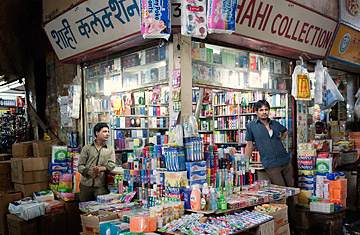
A shop in Mumbai's Crawford Market is characteristic of the mom-and-pop establishments still dotting India.
Adi Godrej is optimistic about India, and for good reason. The chairman of the Mumbai-based Godrej Group has been a big beneficiary of India's economic miracle. The richer that India's 1.2 billion people become, the more Godrej-made refrigerators, furniture and vegetable oil they can buy. Last year Godrej set a goal of increasing sales 10 times in 10 years; so far this year the conglomerate's revenues have surged 30%. "I most definitely feel that India's long-term growth story is intact," says Godrej.
Not everyone shares his enthusiasm. "I wouldn't be bullish," says Vijay Shekhar Sharma, chairman of One97, a company based near New Delhi that offers mobile Internet services to big telecom companies. "Our business could be doing better." A retroactive tax introduced earlier this year on foreign transactions of Indian assets has discouraged investment. "Policy has been a big hurdle for growth," says Sharma. His customers have poor access to credit and often delay paying him for months. Sharma would like to take his company public, but with investor sentiment depressed, he has put off the idea. Such hurdles aren't specific to his firm, he says: "It's an everybody-has-a-problem problem."
That's a big problem for India. By any measure, India has been one of the world's great growth stories over the past two decades. Hundreds of millions have been lifted out of poverty, the entrepreneurial genius of India's business community has been unleashed, and the country has attained a level of influence in the global economy not seen in centuries. At the same time, India always seems to disappoint. Though the ranks of the middle class are swelling, India is still home to more of the world's destitute than anywhere else — 445 million people, a third of the population. While companies like Godrej excel both within and without India, they remain too entangled in red tape to drive the country's growth higher. The private economy, led by innovative firms like IT-services giant Infosys or carmaker Tata Motors, is rewriting the playbook of global business, but the public sector — inefficient, wasteful and corrupt — is incapable of supporting their efforts.
Godrej and Sharma represent a new two Indias: the India of burgeoning wealth that shows the nation's boundless promise and the India of frustrated expectations that exposes how fitfully that potential is being realized. For the country to truly become the world's greatest emerging market, those two Indias must become one. The issue "is not what India is doing, but what India is capable of doing," says Rajya Vardhan Kanoria, president of the Federation of Indian Chambers of Commerce and Industry (FICCI). "That is where the mismatch is."
Slow — and unsteady
To be fair, india has come a long way in a short time. in 1991, then Prime Minister P.V. Narasimha Rao and his finance chief, economist Manmohan Singh, were forced to tackle a debt crisis. They began dismantling India's byzantine web of regulations and permits known as the License Raj, under which business folk could not open a factory, launch a product line or import technology without the approval of overbearing bureaucrats. The reforms yielded spectacular results. GDP has grown on average by 6.5% a year since. Foreign investors from Citibank to Hyundai have charged into the expanding consumer market. India has become a proud member of Goldman Sachs' BRICs, the club of developing nations the bank believes will propel global growth for decades to come.
Yet the reforms have not gone far enough. The government has failed to provide the proper infrastructure and education to build a firmer foundation for rapid growth. Nor has the License Raj been fully put to rest as businessmen, both foreign and local, are still stymied by an intrusive bureaucracy. Next to its more directed (and authoritarian) neighbor China, India usually compares poorly. Last year foreign investment into China reached $124 billion; India earned $32 billion.
Progress is slowed or even halted by the country's fractious democratic politics, with some left-leaning parties ferociously opposed to further liberalization. In 2011, Singh, now Prime Minister in a coalition led by his Indian National Congress, attempted to open India's retail sector to big foreign hypermarkets like Walmart, but in the face of stiff resistance, both in Parliament and on the streets, he backed down. As the reform drive has stalled, so has GDP growth. In October, the International Monetary Fund downgraded the 2012 forecast for India to 4.9%. Flagging Western economies would kill for such a figure, but for India, that would be the slowest growth in a decade. Research firm Capital Economics even worried in an August report that India was suffering from stagflation — that destructive combination of high inflation and low growth. Citing political paralysis, ratings agency Standard & Poor's warned in June that India could become the first BRIC to lose its investment-grade status. That India needs rebooting is evident. Indeed, that's the theme of a World Economic Forum conference taking place in New Delhi in November. Says Anand Mahindra, chairman of Mumbai-based automaker Mahindra & Mahindra: "The last year [for India] has been the most challenging since the reforms [began] for anyone who sees himself as an optimist."
